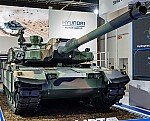Poland's quest for Air Dominance: A spotlight on MSPO 2024
Poland is on a trajectory to redefine its military capabilities, especially in the air domain, amid a rapidly evolving security landscape in Eastern Europe. As the International Defense Industry Exhibition (MSPO) approaches, all eyes are on Poland's ambitious defense modernization plans and its pursuit of air dominance, which could take center stage at the event. This article delves into Poland's strategic priorities, ongoing military contracts, and the significant focus on enhancing its air capabilities.
Poland's accelerated defense modernization
Since Russia's invasion of Ukraine in 2022, Poland has dramatically accelerated its defense modernization efforts. The conflict underscored the urgency for Warsaw to revamp its military capabilities and reduce its reliance on Soviet-era equipment. In response, Poland launched a multi-billion-dollar spending spree, encompassing a broad spectrum of military assets such as Airborne Early Warning aircraft, helicopters, howitzers, light combat aircraft, multi-launch rocket launchers, and tanks.
The urgency of these upgrades is underscored by the remarks of Paweł Bejda, Secretary of State at Poland’s Ministry of National Defence, who revealed in March that over 150 military contracts are set to be signed this year alone. This significant number reflects Poland's commitment to bolstering its defense capabilities and could result in a flurry of orders being finalized at the MSPO.
Shifting dynamics at MSPO
Historically, Poland's defense shows, held annually in Kielce, have been marked by indecision over major acquisitions, political turbulence, and uncertain funding. However, the ongoing war in Ukraine has effectively ended these trends, leading to a substantial increase in defense spending. According to NATO estimates, Poland will spend 4.1% of its GDP on defense in 2024, surpassing all other NATO member countries for the second consecutive year. Moreover, this figure is projected to rise to 5% by 2025, signaling Warsaw's determination to fortify its military posture.
Gen. Wieslaw Kukula, Chief of Staff of the Polish Army, emphasized the need for readiness against potential threats, stating in July that Poland's armed forces must be prepared for a "full-scale conflict." This sentiment is echoed by political leaders, including President Andrzej Duda, who highlighted the importance of building a robust military force to deter any future aggression against Poland. "We must arm ourselves in such a way, secure ourselves in such a way, build up the potential of the Polish army so large that no one ever dares to invade us," Duda declared during a speech on Poland's Armed Forces Day.
Air Dominance: The central theme at MSPO
While a variety of military vehicles and equipment will be showcased at the MSPO, Poland's pursuit of air dominance is expected to be the primary focus. A major component of this effort is the planned acquisition of 32 new fighter jets, a move that has attracted significant attention from international defense contractors.
Currently, Boeing's F-15EX and the Eurofighter Typhoon are strong contenders for the contract. However, Poland is also considering expanding its existing order of Lockheed Martin F-35A jets. In 2020, Warsaw signed a $4.6 billion deal with Washington for 32 F-35A aircraft, with the first jet being unveiled recently at Lockheed Martin's production facility in Fort Worth, Texas. Deliveries are slated to continue until 2030, further enhancing Poland's fifth-generation fighter fleet.
Maj. Gen. Cezary Wisniewski, Deputy Commander of the Polish Armed Forces, noted that a team was sent to Italy to discuss the capabilities of the Eurofighter Typhoon and review its "marketing numbers." However, he also pointed out that a final decision on the contract award would require additional time, as a new government still needed to take office.
Strategic implications and future outlook
Poland's focus on enhancing its air capabilities is part of a broader strategy to ensure national security and maintain a robust deterrence posture in the face of growing regional threats. The decision on which fighter jets to procure will not only shape the future of Poland's air force but also influence its strategic alliances and defense collaborations.
Opting for additional F-35A jets would further strengthen Poland's ties with the United States, while selecting the F-15EX or Eurofighter Typhoon could diversify its defense partnerships. Each option presents distinct advantages: the F-35A offers cutting-edge stealth and sensor technology, the F-15EX provides unmatched payload capacity and range, and the Eurofighter Typhoon boasts a proven track record in European air forces.
As Poland continues to modernize its military, the choices made at the MSPO will have far-reaching consequences for its defense strategy and regional stability. The exhibition will serve as a platform for Poland to showcase its commitment to building a formidable defense force and reaffirm its position as a key player in NATO and European security.
Conclusion
Poland's defense modernization efforts, particularly its quest for air dominance, are poised to be the highlight of this year's MSPO. With over 150 military contracts in the pipeline and a renewed focus on securing advanced fighter jets, Poland is making significant strides towards bolstering its military capabilities and enhancing its strategic position. As Warsaw navigates its options between the F-15EX, Eurofighter Typhoon, and additional F-35As, the decisions made in the coming months will shape the future of its defense posture and its role within the broader NATO alliance.
The MSPO will undoubtedly provide a glimpse into Poland's ambitious defense agenda and its unwavering commitment to national security in an increasingly unpredictable world.








